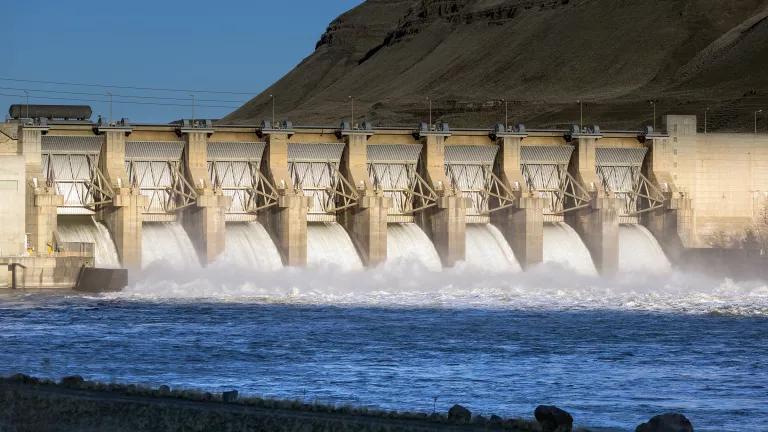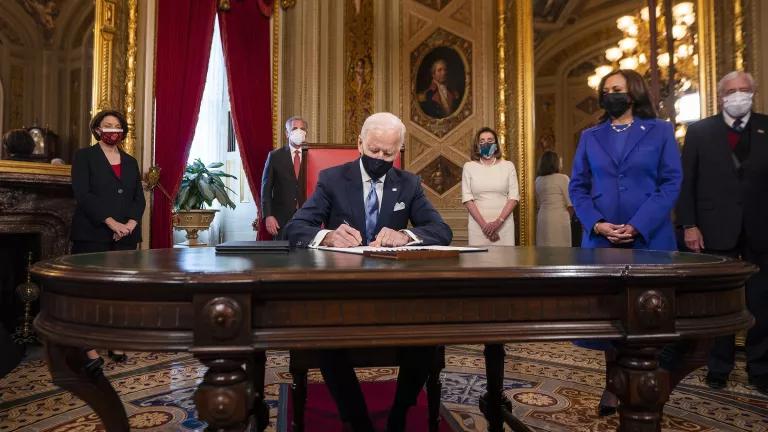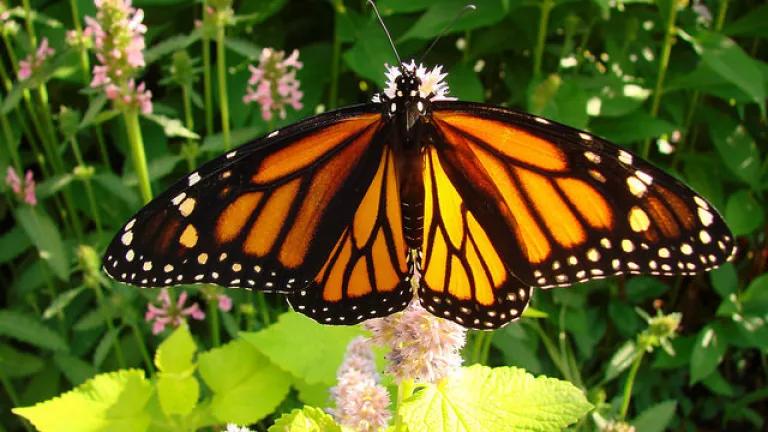Washington State Acts on Snake River Restoration
If the federal government proposes a pathway to comprehensive Snake River restoration, we will all benefit from the important planning and progress underway in Washington State.

The spillway at Lower Monumental Dam on the Snake River, Washington
iStock
A guest blog by Kate White Tudor, NRDC's representative in Olympia, WA.
As parts of the Columbia and Snake rivers warmed to temperatures dangerous for salmon this week, environmental advocates are gearing up for more litigation. The year-long stay is about to expire on the longstanding challenge to the Columbia River hydropower system’s impacts on the endangered fish.
Will the Biden Administration defend the Trump Administration’s hurried environmental review defending the dams? Or will Biden and congressional leaders make good on their promise to deliver a comprehensive solution to the decades-long salmon wars?
If the federal government proposes a pathway to comprehensive Snake River restoration, we will all benefit from the important planning and progress underway in Washington State.
Washington State’s 2023 budget provides funding and direction for state agencies to conduct essential planning to transition the energy, transportation, and irrigation services currently provided by the four aging dams on the lower Snake River. The Snake River is the Columbia’s largest tributary, and these four dams have long been the target of litigation for their outsized impact on salmon survival. The dams are owned and operated by the Army Corps of Engineers; however, the dams are located in Washington State and impact regional and local agriculture and energy issues, as well as regional Tribal nations’ treaty rights, protected resources and way of life—that has been intertwined with Snake River salmon since time immemorial.
In 2022, Senator Patty Murray and Governor Jay Inslee issued recommendations for restoring the Snake River, protecting Snake River salmon from extinction and honoring Tribal treaty rights. The Washington State budget follows through on this work: funding critical analysis in irrigation, transportation and energy sectors to inform plans for replacement of services currently provided by the dams. The vision is to achieve a vibrant and resilient decarbonized energy future in the Northwest alongside a free-flowing Snake River that will restore essential migration habitat for endangered salmon.
Irrigation: Eastern Washington farmers produce fruit, potatoes, asparagus and a wide variety of crops across 53,000 acres in one of the most productive agricultural regions of the world. If the Snake River were to be restored to its natural free-flowing state, irrigators would likely experience larger electricity costs to lift irrigation water from resulting lower river levels onto fields. The Washington State budget includes $500,000 in funding for analysis and planning to ensure irrigation would continue to be available and affordable for farmers during dam drawdown and following river restoration.
Transportation: Historically, dryland wheat and other crops in Eastern Washington were trucked to rail depots and ports for distribution across the world. When the lower Snake River dam system was completed in the 1970s, some of these transportation needs were shifted to barges traveling the Snake and Columbia rivers, which move through locks operated by the Army Corps of Engineers and funded by the federal government. Barge traffic declined substantially between 1995 and 2010 and continues to fall to less than half historic volumes as rail options become more competitive. The Washington State transportation budget includes $5 million to analyze alternatives to replace remaining barge traffic to ensure freight can continue to move to market, at manageable costs, over highways and rail.
Energy: The Washington State 2023-24 operating budget also provides $2 million to develop a detailed plan to replace energy generated by the lower Snake River dams. The Pacific Northwest energy system is well positioned to transition away from the modest amount of power generated by these dams. They provide just 4% of the Pacific Northwest regional electrical capacity, along with certain system ancillary services. Decades of litigation to protect salmon from extinction have cost taxpayers huge sums, decreased energy generation due to court-ordered spill requirements and failed to improve salmon survival. Electrical generation equipment in the dams is aging, and replacement costs in coming years are likely to exceed $600 million.
A number of studies have found that generation from the dams could be replaced with emissions-free renewable power, which improves reliability during the summer and fall when hydro capacity is low. Washington State utilities are already underway in planning their transition to an emissions-free electrical system, required by the state’s Clean Energy Transformation Act.
The 2023-25 Washington state operating budget directs the Washington Department of Commerce to conduct an analysis for “new electricity generation, transmission, ancillary services, efficiency and storage sufficient to offset those presently provided by the lower Snake river dams.” The study must recommend a replacement portfolio of energy resources that improves grid resilience while incorporating energy efficiency, demand response and storage strategies.
The Washington legislature also invested over $300 million in salmon recovery, including funds for riparian habitat restoration, conservation and local government projects. Restoring riverbanks and wetlands doesn’t just help salmon, it’s also important for flood protection, water quality, groundwater recharge, shoreline erosion control, and carbon sequestration.
Accomplishing a free-flowing and fully restored lower Snake River—while maintaining and improving Washington State’s agricultural, transportation and energy services currently provided by the dams—will require a level of effort comparable to that which produced the Federal Columbia River Power System and the many non-federal dams that electrified the Pacific Northwest beginning in the 1930’s. The region is already being forced by climate change to rethink our energy landscape; now is the time to plan for a more diverse, reliable, and equitable network of renewable resources. Washington State’s legislature has taken important steps to accomplish the double tasks of replacing the region’s fossil fuel plants and the most environmentally harmful hydroelectric dams with renewables while repairing the damage done to the salmon and steelhead runs that in so many ways embody the region’s history, values and cultures.
This blog provides general information, not legal advice. If you need legal help, please consult a lawyer in your state.




